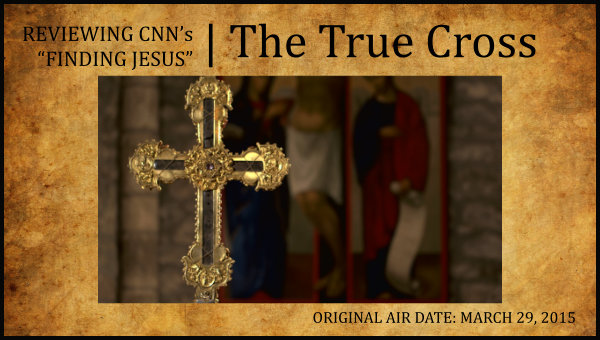By Tyson Thorne

In this next-to-the-last episode of CNN’s special we are treated to a brief history of the finding and dissemination of the true cross. Their stated goal for this episode is in the form of dramatic narration: “Now for the first time modern science sets out to answer the question, is the true cross a hoax that mocks the crucifixion or the relic of relics?” They may have taken on too much.
According to their formula the episode begins with a dramatization of historic events. The events in this story, however, have nothing to do with Biblical history. The story begins in about 330 AD when Roman Empress Helena, the mother of Constantine, travels to Jerusalem on a quest to recover the cross that Jesus was nailed to and died on. She was a follower of Jesus, so her motives were pure and hardly nefarious. She is looking for a physical connection between her savior and herself.
Arriving in Rome she finds a once glorious city in squalor. The Jews had been ejected from the city after their revolt against Rome in 70 AD. It was now a Roman and Gentile provincial capital, full of criminals, scoundrels and villains. It was the Mos Eisley of the fourth century. In the dirt and filth that the city had been reduced to this extraordinarily intelligent and noble woman of faith begins to retrace the steps of Jesus through the city. Enough of the ancient city remained to locate key points, from trial locations, to the Via Delarosa and, eventually, Golgotha itself.
The hill where Jesus was crucified wouldn’t have been easy to find, if not for Emperor Hadrian building a pagan temple over the site in 135 AD as a rebuff of the Christian movement. What Hadrian intended for evil aided Helena in not only finding the venerated location but also in building one of the most ancient Christian churches still standing, the Church of the Holy Sepulcher. It helps, too , that the location is a hill just outside the city as described by the Gospel writers and according to Roman traditions.
Beneath the temple Helena found what she believes is the remnants of the actual cross Jesus had been crucified on. According to legend she had the beam split into pieces for easy travel and sent sections of it all around the Roman Empire. To some degree it doesn’t matter if what she found was the authentic cross or not. Due to her quest and the miraculous vision her son supposedly had on the field of battle, that of a cross in the sky with the message “through this you will conquer”, the cross stopped being associated with execution and humiliation and became the symbol of Christianity for nearly two millennia and counting.
I said “to some degree” it doesn’t matter, unless you want to uncover a “hoax that mocks the crucifixion” itself. What is interesting is that the CNN special makes such a dramatic statement at the beginning of the episode, then never comes back to it again. There is never any indication that a hoax was perpetrated, except perhaps in that some throughout history may have knowingly misrepresented the provenance of wood chips in an attempt to gain favor with church leaders. But this does not indicate a mockery of the crucifixion, and instead only reveals what we already know: some people are prone to cons and others are gullible enough to fall for a con. It is in this regard that I believe the statement was going too far, trying too hard, or making much ado about little.
AS for the science aspect of the show, they use carbon 14 dating to discover the age of a piece of wood that has been thought to be a piece of the true cross for over 1,000 years. I won’t spoil the ending for you.
|
|
